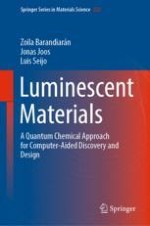This book describes a unique combination of quantum chemical methods for calculating the basic physical properties of luminescent materials, or phosphors. These solid inorganic materials containing an optically active dopant are key players in several major fields of societal interest, including energy-efficient lighting, solar cells, and medical imaging. The novel ab initio methods described in this book are especially designed to target the crowded and complex electronic excited states of lanthanide activators in inorganic solids. The book is well suited to both new and experienced researchers alike and appeals to a broad range of theoretical and experimental backgrounds. The material presented enables an adept understanding of elaborate calculations, which, in tandem with experiments, give essential insight into difficult luminescence problems and quandaries, thus fully preparing the reader for an educated search for new functional luminescent materials
